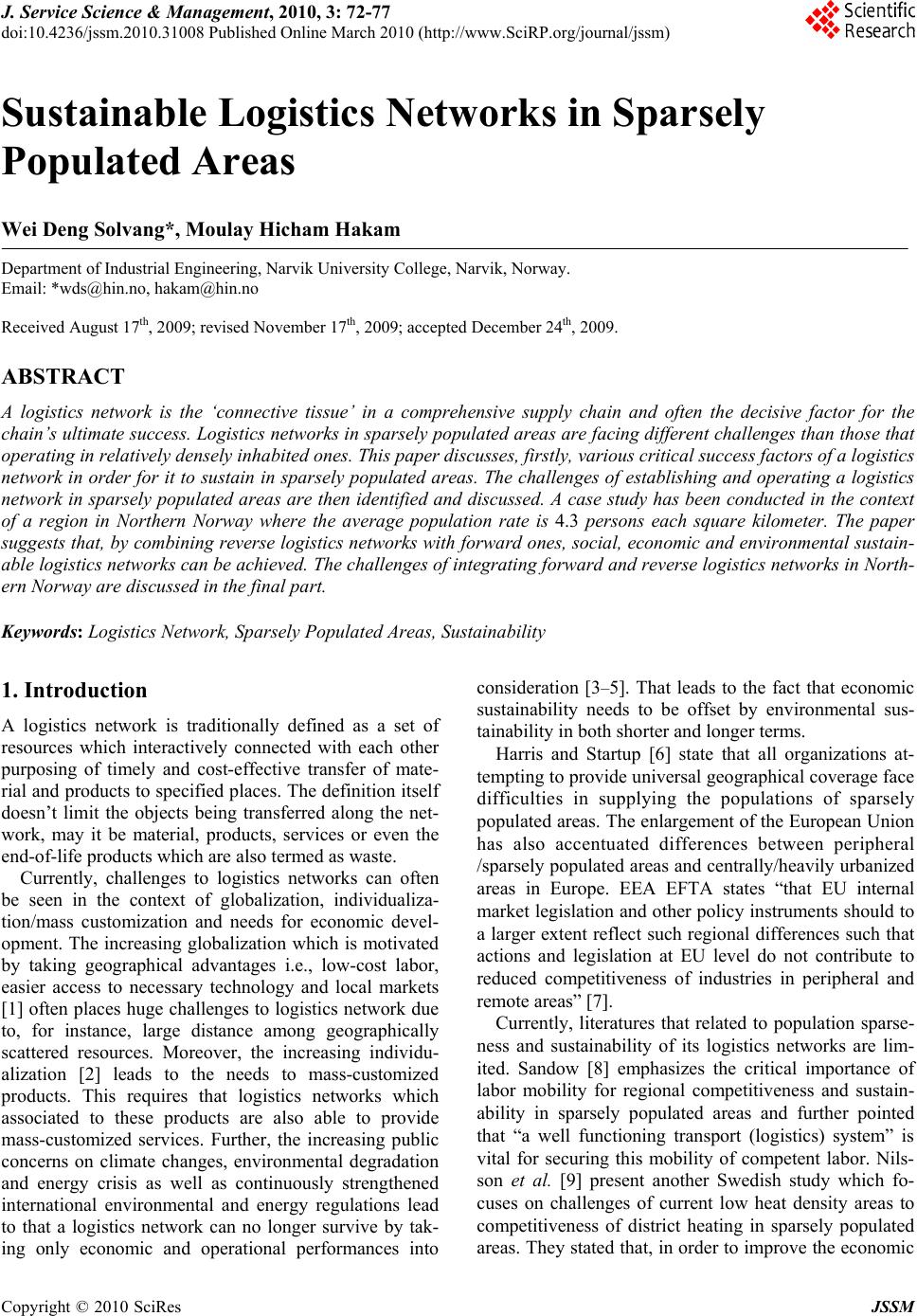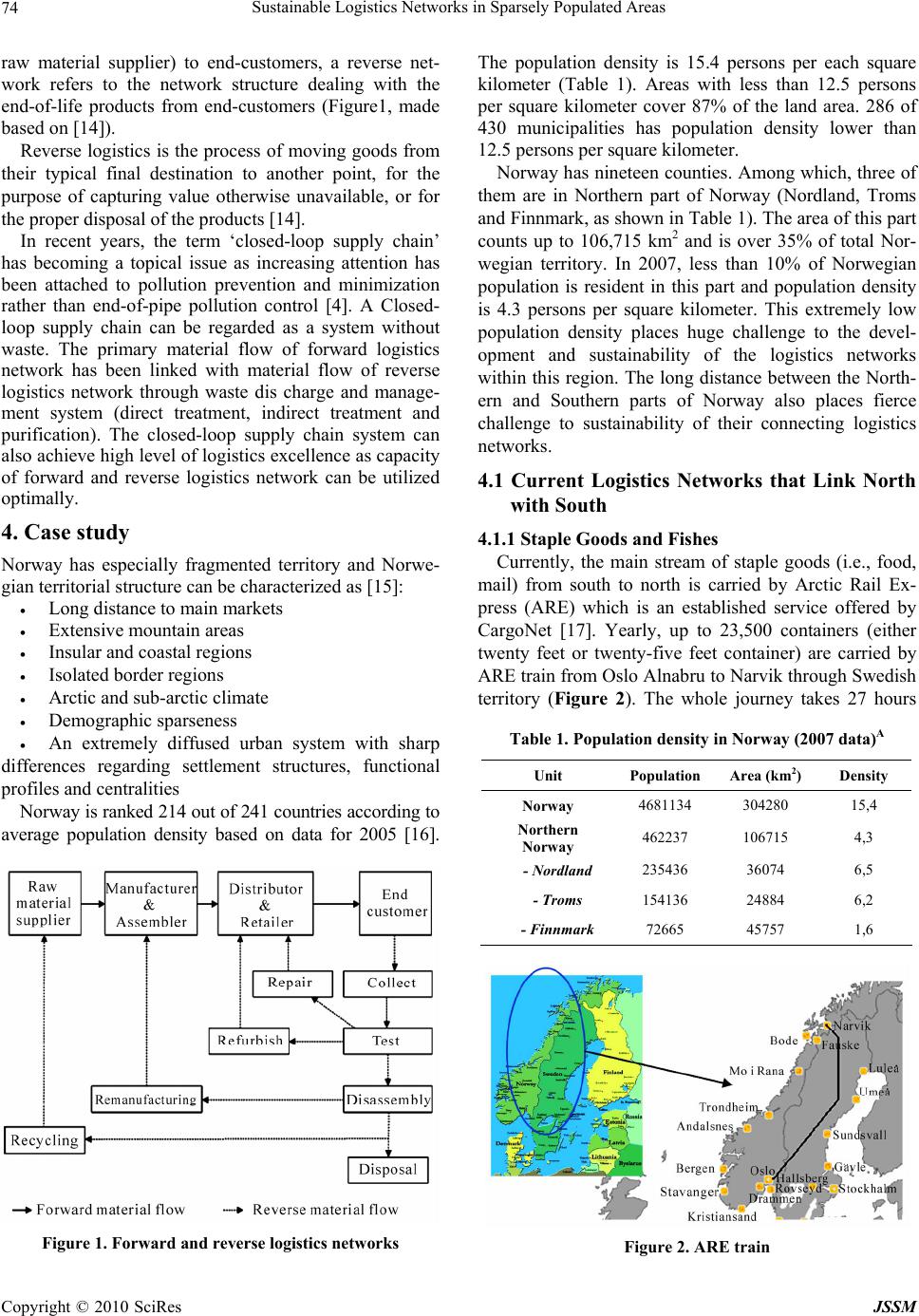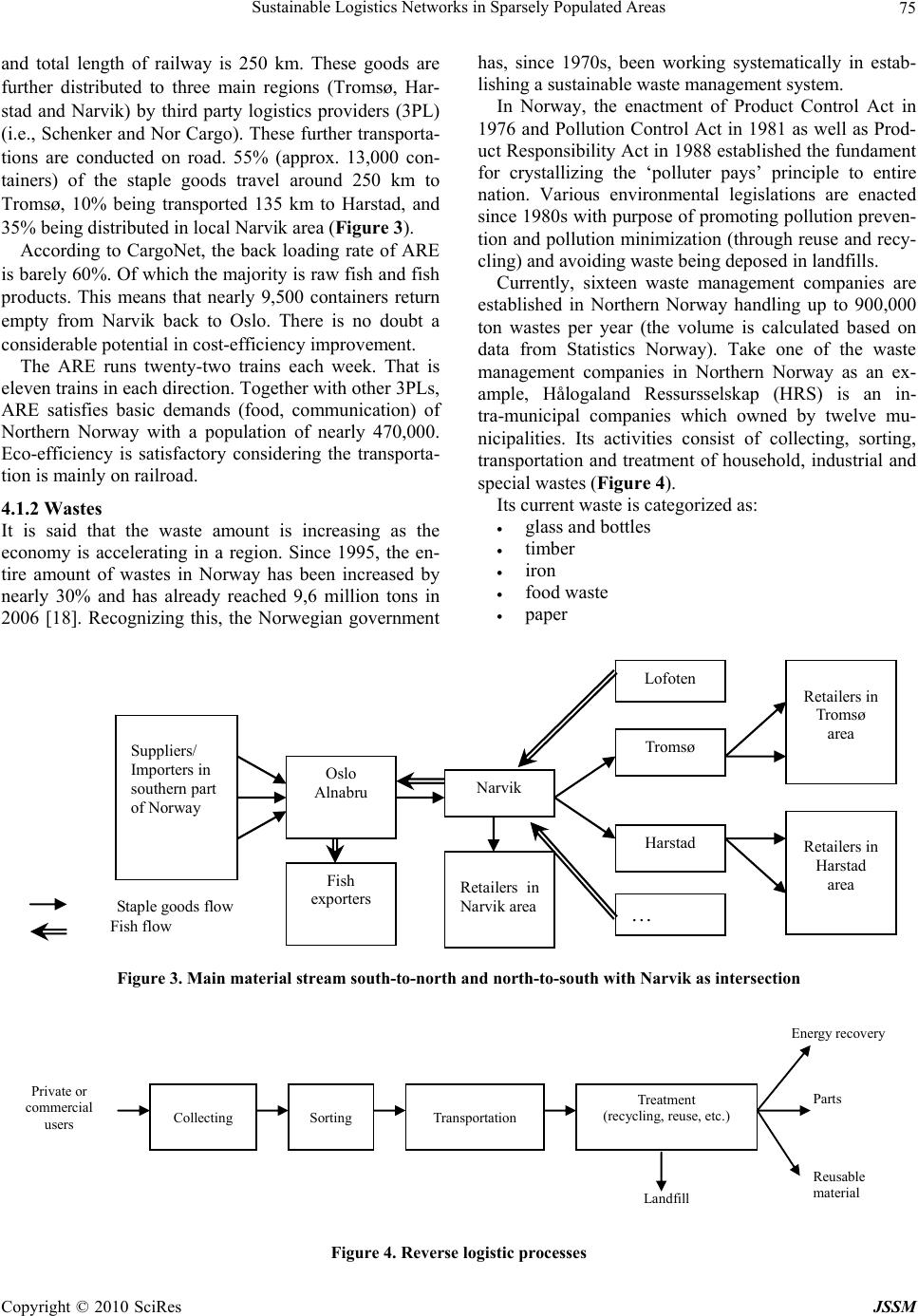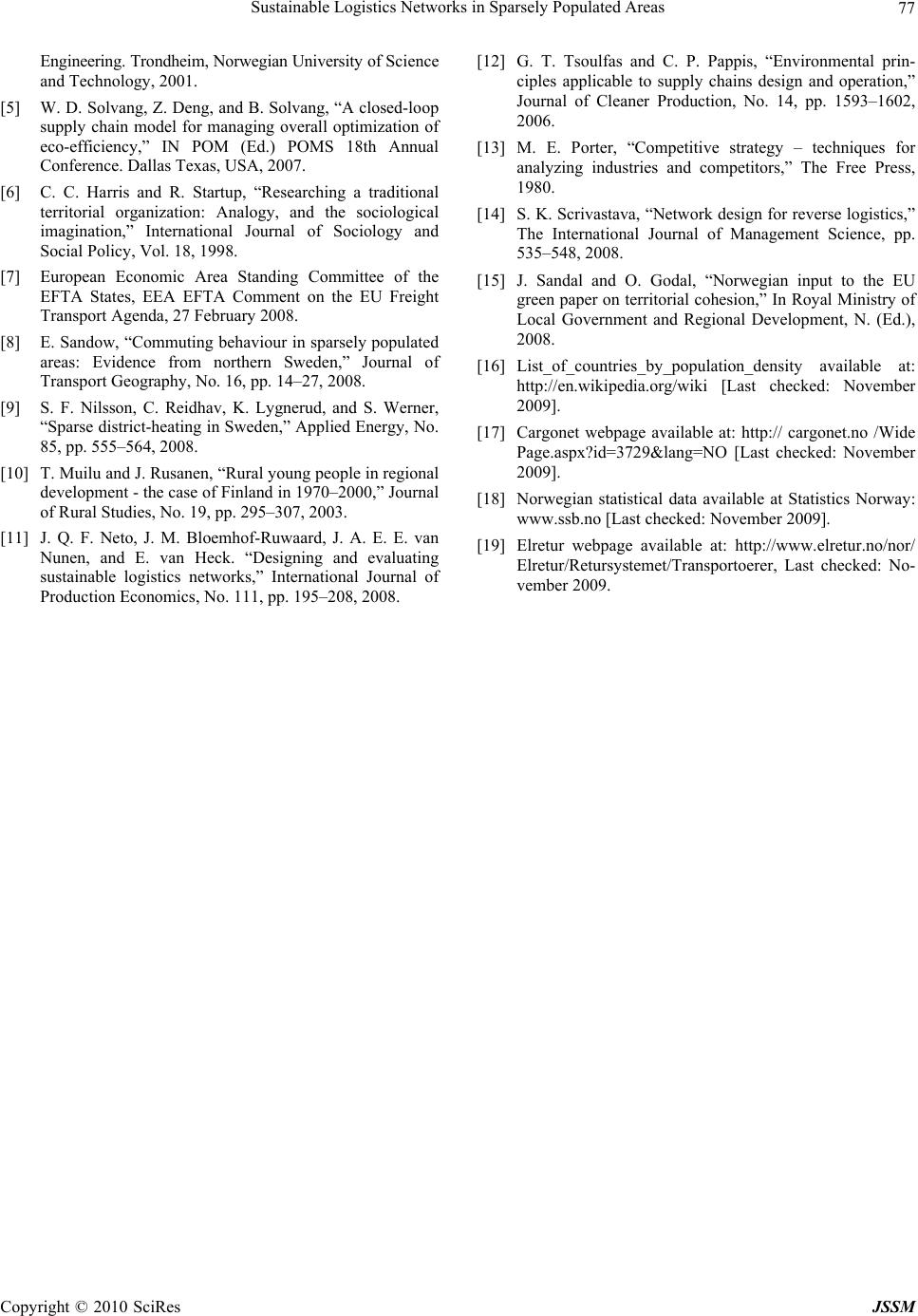Paper Menu >>
Journal Menu >>
 J. Service Science & Management, 2010, 3 : 72 -77 doi:10.4236/jssm.2010.31008 Published Online March 2010 (http://www.SciRP.org/journal/jssm) Copyright © 2010 SciRes JSSM Sustainable Logistics Networks in Sparsely Populated Areas Wei Deng Solvang*, Moulay Hicham Hakam Department of Industrial Engineering, Narvik University College, Narvik, Norway. Email: *wds@hin.no, hakam@hin.no Received August 17th, 2009; revised November 17th, 2009; accepted December 24th, 2009. ABSTRACT A logistics network is the ‘connective tissue’ in a comprehensive supply chain and often the decisive factor for the chain’s ultimate success. Logistics networks in sparsely populated areas are facing different challenges than those that operating in relatively densely inhabited ones. This paper discusses, firstly, various critical success factors of a logistics network in order for it to sustain in sparsely populated areas. The challenges of establishing and operating a logistics network in sparsely populated areas are then identified and discussed. A case study has been conducted in the context of a region in Northern Norway where the average population rate is 4.3 persons each square kilometer. The paper suggests that, by combining reverse logistics n etworks with forward ones, social, economic and environmen tal sustain- able logistics networks can be achieved. The challenges of integrating forward and reverse logistics networks in North- ern Norway are discussed in the final part. Keywords: Logistics Network, Sparsely Populated Areas, Sustainability 1. Introduction A logistics network is traditionally defined as a set of resources which interactively connected with each other purposing of timely and cost-effective transfer of mate- rial and products to specified places. The definition itself doesn’t limit the objects being transferred along the net- work, may it be material, products, services or even the end-of-life products which are also termed as waste. Currently, challenges to logistics networks can often be seen in the context of globalization, individualiza- tion/mass customization and needs for economic devel- opment. The increasing globalization which is motivated by taking geographical advantages i.e., low-cost labor, easier access to necessary technology and local markets [1] often places huge challeng es to logistics network due to, for instance, large distance among geographically scattered resources. Moreover, the increasing individu- alization [2] leads to the needs to mass-customized products. This requires that logistics networks which associated to these products are also able to provide mass-customized services. Further, the increasing public concerns on climate changes, environmental degradation and energy crisis as well as continuously strengthened international environmental and energy regulations lead to that a logistics network can no longer survive by tak- ing only economic and operational performances into consideration [3–5]. That leads to the fact that economic sustainability needs to be offset by environmental sus- tainability in both shorter and longer terms. Harris and Startup [6] state that all organizations at- tempting to provide universal geographical coverage face difficulties in supplying the populations of sparsely populated areas. The enlargement of the European Union has also accentuated differences between peripheral /sparsely populated areas and centrally/heavily urbanized areas in Europe. EEA EFTA states “that EU internal market legislation and other policy instruments should to a larger extent reflect such regional differences such that actions and legislation at EU level do not contribute to reduced competitiveness of industries in peripheral and remote areas” [7]. Currently, literatures that related to population sparse- ness and sustainability of its logistics networks are lim- ited. Sandow [8] emphasizes the critical importance of labor mobility for regional competitiveness and sustain- ability in sparsely populated areas and further pointed that “a well functioning transport (logistics) system” is vital for securing this mobility of competent labor. Nils- son et al. [9] present another Swedish study which fo- cuses on challenges of current low heat density areas to competitiveness of district heating in sparsely populated areas. They stated that, in order to improve the economic  Sustainable Logistics Networks in Sparsely Populated Areas Copyright © 2010 SciRes JSSM 73 sustainability of district h eating in less densely populated areas, the rate of expansion in the detached-house seg- ment needed to be increased. Muilu and Rusanen [10] document an increasing urbanization in Finland from 1970 to 2000. Same trend can be confirmed in Norway and Sweden. According to Muilu and Rusanen [10], as Finnish population continuous to increase, the number and proportion of young people have declined in rural municipalities. This resettlement of young people from peripheral areas to the built-up ones resulted in a di- chotomy between the sparsely and densely populated areas which further accentuated by the distortion of population st ru cture a n d gen d er rati o . According to Neto et al. [11], the increasing focus on climate changes and pollution reduction from both pub- lics and governments in recent years has aroused great interests of as well as large pressure on how logistics networks should operate. They proclaim that the objec- tive in design a logistic network has changed, from cost minimization only to cost and environmental impact minimization. Tsoulfas and Pappis [12] propose some environmental principles for companies to be able to obtain a sustainable supply chain. Their argument is that by obtaining sustainable functions inside, outside and among companies along the chain, a competitive supply chain can be achieved in a long-term perspective. The logistics function is defined as one of five focuses in their research. Unfortunately, the study is still on con- ceptual level and hasn’t provided any practical measures that can be used for logistics networks to achieve their sustainability. This paper aims to shed light on challenges to eco- nomic and environmental sustainability of logistics net- works in sparsely populated areas. The economic and environmental sustainability are interrelated and need to be detailed into some manageable concepts. Therefore three critical success factors are explored and discussed in the section that followed. A review of forward and reverse logistics n etworks is conducted purposing to pr o- vide the theoretical background for a case study of cur- rent logistics networks in Northern Norway. Based on the analysis on current logistics networks, the authors give several suggestions on how economic as well as envi- ronmental sustainability might be improved in these networks. 2. Critical Success Factors for the Success of Logistics Networks that Operating in Sparsely Populated Areas A logistics network is a critical element for national, re- gional and community development, especially in a frag- mented landscape with high demographic sparseness. Providing necessary level of logistics excellence in such an area prevents depopulation from the region and is vital for the region’s economic development. Comparing with logistics networks in densely populated areas, those in sparsely populated areas are facing different strategic and operational challenges. Generally, an organization may sustain when compet- ing with any of three advantages, namely, overall cost leadership, differentiation and focus [13]. The first factor is concerned with cost-effectiveness; the second repre- sents the uniqueness of the product as perceived by the customer. As for the third factor, the key idea is to serve a particular target very well. One of the most significant differences between densely and sparsely populated areas is the size of popu- lation a logistics network aims to serve. A densely popu- lated area has usually large enough concourse which provides necessary basis for the network to take the ad- vantages of both economy-of-scale and economy- of-scope. Logistics networks in sparsely populated area, however, usually do not possess necessary prerequisites for taking these advantages. Another difference is the distance. A logistics network in a densely populated area is less distant between two resources (i.e., between a distribution centre and a re- tailer). This may easily enable, for example, the network to achieve more mass-customized logistics service with diverse focuses. The third difference is that a sparsely populated area is usually situated in a peripheral region of a country. De- veloping logistics networks that connecting sparsely and densely populated areas needs to be viewed in conjunc- tion with offering universal geographical coverage for social and economic development as well as sustainable regional development in whole territory. By doing so, risks such as social degradation and depopulation can be prevented or m i nimized. Different strategies needs to be applied to handle the challenges mentioned above. The critical success factors for logistics networks operating in sparsely populated areas are therefore: Cost-effectiveness: refers to the extent to which customer requirements are met given a limited level of cost. Cost-efficiency: a measure of how economically a network’s resources are utilized when providing a given level of customer satisfaction. Eco-efficiency: the efficiency with which re- sources are converted into product. 3. Forward and Reverse Logistics Network As mentioned earlier, a logistics network links difference resources in the way that tangible or intangible objects (i.e., material, parts, products, service and waste) being transferred within the network and towards a clearly de- fined destination. While a forward logistics network brings raw material or new products from origin (e.g., a  Sustainable Logistics Networks in Sparsely Populated Areas Copyright © 2010 SciRes JSSM 74 raw material supplier) to end-customers, a reverse net- work refers to the network structure dealing with the end-of-life products from end-customers (Figure1, made based on [14]). Reverse logistics is the process of moving goods from their typical final destination to another point, for the purpose of capturing value otherwise unavailable, or for the proper d i sposal of the pr o d uct s [14]. In recent years, the term ‘closed-loop supply chain’ has becoming a topical issue as increasing attention has been attached to pollution prevention and minimization rather than end-of-pipe pollution control [4]. A Closed- loop supply chain can be regarded as a system without waste. The primary material flow of forward logistics network has been linked with material flow of reverse logistics network through waste dis charge and manage- ment system (direct treatment, indirect treatment and purification). The closed-loop supply chain system can also achieve high level of logistics excellence as capacity of forward and reverse logistics network can be utilized optimally. 4. Case study Norway has especially fragmented territory and Norwe- gian territorial structure can be characterized as [15]: Long distance to main markets Extensive mountain areas Insular and coastal reg ions Isolated border regions Arctic and sub-arctic climate Demographic sparseness An extremely diffused urban system with sharp differences regarding settlement structures, functional profiles and centralities Norway is ranked 214 out of 241 countries according to average population density based on data for 2005 [16]. Figure 1. Forward and reverse logistics networks The population density is 15.4 persons per each square kilometer (Table 1). Areas with less than 12.5 persons per square kilometer cover 87% of the land area. 286 of 430 municipalities has population density lower than 12.5 persons per square kilometer. Norway has nineteen counties. Among which, three of them are in Northern part of Norway (Nordland, Troms and Finnmark, as shown in Table 1). Th e area of th is part counts up to 106,715 km2 and is over 35% of total Nor- wegian territory. In 2007, less than 10% of Norwegian population is resident in this part and population density is 4.3 persons per square kilometer. This extremely low population density places huge challenge to the devel- opment and sustainability of the logistics networks within this region. The long distance between the North- ern and Southern parts of Norway also places fierce challenge to sustainability of their connecting logistics networks. 4.1 Current Logistics Networks that Link North with South 4.1.1 Staple Goods and Fishes Currently, the main stream of staple goods (i.e., food, mail) from south to north is carried by Arctic Rail Ex- press (ARE) which is an established service offered by CargoNet [17]. Yearly, up to 23,500 containers (either twenty feet or twenty-five feet container) are carried by ARE train from Oslo Alnabru to Narvik through Swedish territory (Figure 2). The whole journey takes 27 hours Table 1. Population density in Norway (2007 data)A Unit Population Area (km2) Density Norway 4681134 304280 15,4 Northern Norway 462237 106715 4,3 - Nordland 235436 36074 6,5 - Troms 154136 24884 6,2 - Finnmark 72665 45757 1,6 Figure 2. ARE train  Sustainable Logistics Networks in Sparsely Populated Areas Copyright © 2010 SciRes JSSM 75 and total length of railway is 250 km. These goods are further distributed to three main regions (Tromsø, Har- stad and Narvik) by third party logistics providers (3PL) (i.e., Schenker and Nor Cargo). These further transporta- tions are conducted on road. 55% (approx. 13,000 con- tainers) of the staple goods travel around 250 km to Tromsø, 10% being transported 135 km to Harstad, and 35% being distributed in local Narvik area (Figu r e 3). According to CargoNet, the back loading rate of ARE is barely 60%. Of which the majority is raw fish and fish products. This means that nearly 9,500 containers return empty from Narvik back to Oslo. There is no doubt a considerable potential in cost-efficiency improvement. The ARE runs twenty-two trains each week. That is eleven trains in each direction. Together with other 3PLs, ARE satisfies basic demands (food, communication) of Northern Norway with a population of nearly 470,000. Eco-efficiency is satisfactory considering the transporta- tion is mainly on railroad. 4.1.2 Wastes It is said that the waste amount is increasing as the economy is accelerating in a region. Since 1995, the en- tire amount of wastes in Norway has been increased by nearly 30% and has already reached 9,6 million tons in 2006 [18]. Recognizing this, the Norwegian government has, since 1970s, been working systematically in estab- lishing a sustainable waste management system. In Norway, the enactment of Product Control Act in 1976 and Pollution Control Act in 1981 as well as Prod- uct Responsibility Act in 1988 estab lished the fundament for crystallizing the ‘polluter pays’ principle to entire nation. Various environmental legislations are enacted since 1980s with purpose of promoting pollution preven- tion and pollution minimization (through reuse and recy- cling) and avoiding waste being deposed in landfills. Currently, sixteen waste management companies are established in Northern Norway handling up to 900,000 ton wastes per year (the volume is calculated based on data from Statistics Norway). Take one of the waste management companies in Northern Norway as an ex- ample, Hålogaland Ressursselskap (HRS) is an in- tra-municipal companies which owned by twelve mu- nicipalities. Its activities consist of collecting, sorting, transportation and treatment of household, industrial and special wastes (Figure 4). Its current waste is categorized as: glass and bottles timber iron food waste paper Narvik Oslo Alnabru Suppliers/ Importers in southern pa rt of Norway Tromsø Harstad Retailers in Tromsø area Retailers in Harstad area Retailers in Narvik area … Lofoten Fish expor ter s Staple goods flow Fish flow Figure 3. Main material stream south-to-north and north-to-south with Narvik as intersection Landfill Private or commercial users Collecting Sorting T ransportation Treatment (recyclin g, reu se, etc.) Energy recovery Parts Reusable material Figure 4. Reverse logistic processes  Sustainable Logistics Networks in Sparsely Populated Areas Copyright © 2010 SciRes JSSM 76 corrugated cardboard plastics from industries beverage pape rboard box waste of electrical and electronic equipment (WEEE) hazardous waste Most of the waste goes to recycling, nearly 90% in 2005. Taking this as key f igure, the recycling volume can be estimated up to around 800,000 tons in Northern Nor- way. Currently, large portion of the recyclable wastes is transported to the Southern part of Norway where the majority of recycling facilities are. The transportation is mainly on road with trucks or semi-trailers. 4.2 The Potential and Challenges of Integrating Forward and Reverse Logistics Networks It is undoubtedly that there is a huge potential of inte- grating forward logistic network (of staple goods and fish) with reverse logistics network (of wastes) with Narvik as the junction point. By doing so, the biggest gain is the reduction of empty container back to Oslo. This will, to a large extent, increasing cost-efficiency of both logistics networks. This will also lead to the reduction of trans- portation price. Together with regular as well as frequent transportation between south and north, a cost-effective logistics network can be achieved. Further, as the inte- gration will ‘lift’ goods from road to track, significant environmental profit (i.e., less pollution and noise) and social gains (i.e., less traffic accidents) can be obtained. However, challenges for this integration are many. First of all, current waste management system has ob- tained itself an exclusive logistics network. Take Elretur AS for example, as one of four take-back companies ap- proved by Norwegian Pollution Control Authority (SFT), Elretur AS collects over 76,000 ton WEEE in 2007. The company cooperates with seven 3PLs for collectin g from entire Norway [19]. One of these companies is Østbø AS which has full authority and responsibility for collection of WEEE in Northern Norway. Østbø AS has its own closed system for transporting WEEE to treatment plan ts in Southern part of Norway. The transportation from Northern Norway to Østbø AS and from Østbø AS to Southern Norway is mainly on road. Secondly, the hygienic requirements of transporting foods and other staple goods from south to north may place the challenge to return wagons loaded by wastes. The traditional perception of waste may also create scep- ticism at staple good s owners and therefore may result in reduced logistics flow from south to north. 5. Summary and Discussion The paper presents a conceptual study on logistic net- works in sparsely populated area. As opposite to densely populated areas, sparsely populated ones place larger challenge to their logistic networks. The limitations of such areas include that the demand volume does not jus- tify economy-of-scale or economy-of-scope. Larger dis- tance between two resources within a network is also a significant challenge. That a sparsely populated area usually situated in a peripheral to den sely populated on es place also the challenge to the logistics connection of these areas. This paper proposed three critical success factors for logistics networks operating in sparsely populated area. By conducting the case study, the authors argued that, in order to achieve cost-efficiency, cost-effectiveness and eco-efficiency of main logistics network that connecting Northern Norway with the Southern part, the potential of utilizing existing south-north logistics network (for staple goods and fish) for north-south transportation of wastes is considerably large. However, currently exclusive waste management systems and traditional perception of waste may place the largest challenges to this possible solution. Benchmarking of performances in terms of cost- ef- fectiveness, cost-efficiency, and eco-efficiency of cur- rent logistics networks (separated networks for staple goods and waste) with that of suggested logistics net- work (transport waste with logistics network of staple goods) need to be conducted in order to provide the quantified justification for the suggested solution. The authors also suggest that a study that mapping all goods flows at a more detail level should be conducted in or- der to provide an overall optimal logistics solution in Northern Norway. 6. Acknowledgment The authors have received great support from different organizations and companies during this study. Here we would thank especially Jan Viggo Fredheim at CargoNet, Line Dalhaug at HRS and Ole Viggo Svendsen at Elretur AS for enthusiasm and information. REFERENCES [1] S. Chopra and P. Meindl, “Supply chain management - strategy, planning, and operation,” Pearson Educational International, 2004. [2] E. Alfnes, “Enterprise reengineering – a strategic frame- work and methodology,” Department of Production and Quality Engineering, Faculty of Engineering Science and Technology, Trondheim, Norwegian Uni versity of Sci enc e and Technology, 2005. [3] F. Du and W. Evans, “A bi-objective reverse logistics network analysis for post-sale service,” Computers and Operations Research, pp. 2617–2634, 2008. [4] W. D. Solvang, “Architecture for supply chain analysis and methodology for quantitative measurement of supply chain flexibility,” Department of Production and Quality  Sustainable Logistics Networks in Sparsely Populated Areas Copyright © 2010 SciRes JSSM 77 Engineering. Trondheim, Norwegian Univer sity of S ci en ce and Technology, 2001. [5] W. D. Solvang, Z. Deng, and B. Solvang, “A closed-loop supply chain model for managing overall optimization of eco-efficiency,” IN POM (Ed.) POMS 18th Annual Conference. Dallas Texas, USA, 2007. [6] C. C. Harris and R. Startup, “Researching a traditional territorial organization: Analogy, and the sociological imagination,” International Journal of Sociology and Social Policy, Vol. 18, 1998. [7] European Economic Area Standing Committee of the EFTA States, EEA EFTA Comment on the EU Freight Transport Agenda, 27 February 2008. [8] E. Sandow, “Commuting behaviour in sparsely populated areas: Evidence from northern Sweden,” Journal of Transport Geography, No. 16, pp. 14–27, 2008. [9] S. F. Nilsson, C. Reidhav, K. Lygnerud, and S. Werner, “Sparse district-heating in Sweden,” Applied Energy, No. 85, pp. 555–564, 2008. [10] T. Muilu and J. Rusanen, “Rural young people in regional development - the case of Finland in 1970–2000,” Journal of Rural Studies, No. 19, pp. 295–307, 2003. [11] J. Q. F. Neto, J. M. Bloemhof-Ruwaard, J. A. E. E. van Nunen, and E. van Heck. “Designing and evaluating sustainable logistics networks,” International Journal of Production Economics, No. 111, pp. 195–208, 2008. [12] G. T. Tsoulfas and C. P. Pappis, “Environmental prin- ciples applicable to supply chains design and operation,” Journal of Cleaner Production, No. 14, pp. 1593–1602, 2006. [13] M. E. Porter, “Competitive strategy – techniques for analyzing industries and competitors,” The Free Press, 1980. [14] S. K. Scrivastava, “Network design for reverse logistics,” The International Journal of Management Science, pp. 535–548, 2008. [15] J. Sandal and O. Godal, “Norwegian input to the EU green paper on territorial cohesion,” In Royal Ministry of Local Government and Regional Development, N. (Ed.), 2008. [16] List_of_countries_by_population_density available at: http://en.wikipedia.org/wiki [Last checked: November 2009]. [17] Cargonet webpage available at: http:// cargonet.no /Wide Page.aspx?id=3729&lang=NO [Last checked: November 2009]. [18] Norwegian statistical data available at Statistics Norway: www.ssb.no [Last checked: November 2009]. [19] Elretur webpage available at: http://www.elretur.no/nor/ Elretur/Retursystemet/Transportoerer, Last checked: No- vember 2009. |

